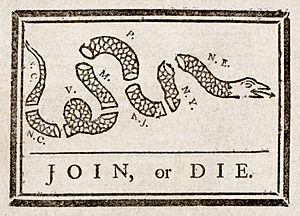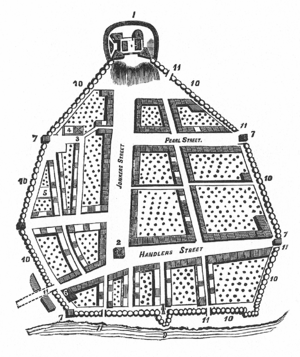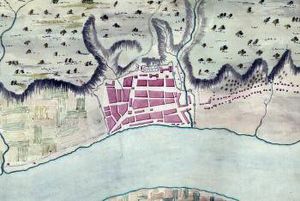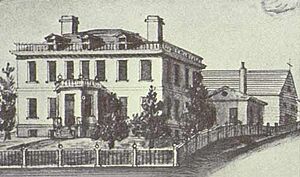History of Albany, New York (1664–1784) facts for kids
The history of Albany, New York from 1664 to 1784 tells the story of Albany when the English took control of New Netherland. This period ended in 1784 with the Treaty of Paris, which officially finished the Revolutionary War.
When the English took over in 1664, the town of Beverwijck was renamed Albany. This name honored the Duke of Albany, who later became King James II of England. The title "Duke of Albany" was a Scottish title, often given to a younger son of the King of Scots. The name "Albany" comes from Alba, the Gaelic name for Scotland.
The Dutch briefly got Albany back in August 1673 and called it Willemstadt. But the English took permanent control again with the Treaty of Westminster (1674). On November 1, 1683, the Province of New York was divided into counties. Albany County was the largest. It included most of what is now New York State north of Dutchess and Ulster Counties. It also included Bennington County, Vermont. Albany became the county seat, which is like the main city for the county.
Albany officially became a city on July 22, 1686. This happened when provincial Governor Thomas Dongan signed the Dongan Charter. This charter was very similar to the one given to New York City a few months earlier. The charter made Albany a strip of land about 1 mile (1.6 km) wide and 16 miles (26 km) long. Over time, Albany lost land to the west but gained land to the north and south. At this time, Albany had about 500 people.
In 1754, leaders from seven British North American colonies met in Albany's city hall, called the Stadt Huys. This meeting was called the Albany Congress. Benjamin Franklin from Pennsylvania presented the Albany Plan of Union. This was the first formal idea to unite the colonies. Even though the British Parliament never approved it, it was an important step towards the United States Constitution. That same year, the French and Indian War began. This war, part of a series of conflicts since 1689, ended in 1763 with France's defeat. This was good for Albany, as the war had been a constant threat and slowed its growth.
In 1775, during the Revolutionary War, the Stadt Huys became the home of the Albany Committee of Correspondence. This group was the political part of the local revolutionary movement. They took over Albany's government and eventually controlled all of Albany County. Tories (people loyal to Britain) and prisoners of war were often jailed there. In 1776, Philip Livingston, who was from Albany, signed the Declaration of Independence in Philadelphia.
During and after the Revolutionary War, many land deals happened in Albany County. After Horatio Gates won against John Burgoyne at Saratoga in 1777, the upper Hudson Valley was mostly peaceful. People from Vermont and Connecticut started moving to the area. They liked living near the Hudson River and trading in Albany. It was also only a few days' sail from New York City. In 1790, the first national census showed Albany had 3,498 people. This was a huge increase since it became a city. In 1797, Albany became the permanent state capital of New York. Before this, the Legislature often moved the capital between Albany, Kingston, Poughkeepsie, and New York City. Albany is the second oldest state capital in the United States.
Albany's Early Years (1664–1744)
Before the Second Anglo-Dutch War, King Charles II of England gave a large area of land to his brother, James, Duke of York. This land stretched from Maine to Delaware and included all of New Netherland. In April 1664, four English ships with 450 soldiers sailed to New Amsterdam (now New York City). Sixteen days later, Fort Orange surrendered to the English. Fort Orange was renamed Fort Albany, and the village of Beverswyck became Albany. This was to honor the Duke of York and Albany, who later became King James II of England. Captain John Manning was put in charge of Fort Albany.
The Dutch briefly took Albany back in 1673 and called it Willemstadt. But the English regained control in November 1674. During the Dutch control, Fort Albany was called Fort Nassau. This was to avoid confusion with New York City, which was renamed New Orange. After the English took over again, all names went back to their English versions. In 1676, Governor Edmund Andros had Fort Frederick built. This new fort was at the top of Yonkers Street (now State and Lodge streets). It replaced Fort Albany, which was closer to the Hudson River.
Albany officially became a city when Governor Thomas Dongan signed its charter on July 22, 1686. At this time, Albany had only about 500 people. The "Dongan Charter" was very similar to the charter given to New York City a few months earlier. Pieter Schuyler became Albany's first mayor on the day the charter was signed. The charter set the city's boundaries. Patroon Street (now Clinton Avenue) was the northern border. The "northern tip of Martin Gerritsen's Island" was the southern border. Both lines stretched 16 miles (26 km) to the northwest. Albany also got the right to buy land in "Schaahtecogue" (now Schaghticoke) and "Tionnondoroge" (now Fort Hunter).
In 1689, Albany became a center of resistance against Jacob Leisler. Leisler had taken control of the colony during a time of confusion called Leisler's Rebellion. Leisler tried to appoint a new mayor for Albany, but the city leaders, including Mayor Schuyler, did not accept him.
On February 8, 1690, the nearby settlement of Corlear (now Schenectady) was attacked by the French and their Native American allies. More than 60 people were killed, and many were taken prisoner. Simon Schermerhorn rode all night to Albany to warn them. This event, known as the Schenectady Massacre, is remembered every year. The mayor of Schenectady rides a horse to Albany's city hall as part of the celebration.
After Pieter Schuyler, Johannes Abeel became Albany's second mayor in 1694. His term lasted only one year. In 1695, Evert Bancker was appointed as the third mayor.
Because of increased pirate activity on the Hudson River, one of the city leaders, Robert Livingston, worked with New York Governor Richard Coote. They planned to destroy pirate bases in the West Indies. Captain William Kidd was hired to lead this mission.
In 1710, a census showed that Albany's population had more than doubled since it became a city in 1686. The city had 1,136 people, including 113 slaves.
Queen Anne gave the Anglican (English church) community in Albany permission to build a church. After many years of arguments with the city council, which was mostly Dutch Reformed, Saint Peter's was finally built in 1717. It was the first Anglican church in New York west of the Hudson River. It is located at the corner of State Street and Lodge Street.
In 1722, important talks happened in Albany between the Iroquois and the provinces of New York, Pennsylvania, and Virginia. This led to the Treaty of Albany, which limited the Iroquois to west of the Blue Ridge Mountains. In 1731, Albany received its first simple fire engine from England. This engine could "spout water" onto fires from a safer distance than using buckets.
Albany Before the American Revolution (1744−1775)
France and Britain declared war in 1744. Soon after, troops gathered in Albany to prepare for an invasion north into French Canada. French Canadians and Native Americans attacked settlements north of Albany in 1745. This forced people to flee to Albany for safety. In response, Colonel William Johnson met with leaders from the Iroquois Confederacy in Albany in 1746. He successfully convinced them to declare war against the French. In 1748, peace came between France and Britain with the signing of the Treaty of Aix-la-Chapelle.
In 1751, a conference was held in Albany. It included representatives from the Iroquois Nation, New York Governor George Clinton, and Indian commissioners from South Carolina, Massachusetts, Connecticut, and the Catawba tribe.

The British feared another war with France. In 1753, they suggested that the colonies meet in Albany to discuss their common defense. The next year, most colonies attended. Benjamin Franklin of Pennsylvania presented what is now known as the Albany Plan of Union. This meeting, called the Albany Congress, took place at Broadway and Hudson Avenue. Although the British Parliament never adopted it, it was an important step towards the United States Constitution. One month later, fears of war with France came true. New fences and defenses were built in Albany.
During the French and Indian War, Albany was a key target for the French. They wanted to cut the British colonies in half. Albany was also where British and colonial troops gathered. Several invasions of French Canada, especially Montreal, were planned from Albany. By 1756, 10,000 soldiers were training in Albany. A smallpox epidemic also occurred. Many refugees and soldiers continued to arrive in the city as fighting increased. Because of the large number of British soldiers, British customs became popular in Albany. The first play in the city was performed in the winter of 1757 by British officers.
General James Abercrombie's troops were stationed across the river from Albany in Greenbush, near Fort Crailo. Dr. Shackburg of the British army wrote "Yankee Doodle Dandy" to make fun of the colonial militias. In 1758, General Lord George Augustus Howe was killed at the Battle of Ticonderoga. He was buried in Albany, under the front entrance of Saint Peter's Church on State Street. He is the only British Lord buried in the United States. The Schuyler Mansion was built in 1761 for General Philip Schuyler. Famous visitors later included George Washington, Benjamin Franklin, and Aaron Burr.
In 1763, Albany bought a second fire engine. Before 1766, Albany had no permanent docks. So, that year, the city council built three stone docks. Each was 80 feet (24 m) long and between 30 and 40 feet (9.1 and 12.2 m) wide. In 1770, Abraham Cuyler became the last mayor appointed under a British Royal Commission. Also in 1770, a fourth dock was built. The sloop Olive Branch became the first Albany ship to sail to the West Indies. The Gazette became Albany's first newspaper, first published in 1771.
Albany During the American Revolution
By 1774, events in other colonies about taxes from the British Parliament brought Albany into the larger issue of colonial unity. This was the first time since the Albany Congress. John Barclay became chairman of the new Committee of Superintendence and Correspondence. This committee chose delegates from Albany to a provincial congress in New York. This congress would then select delegates for the Continental Congress in Philadelphia. Only Philip Schuyler was chosen to represent the colony in Philadelphia. In 1775, the Continental Congress sent a committee to Albany. They wanted to make a treaty with the Iroquois to ensure their help or neutrality. The talks ended without a clear decision and were ultimately unsuccessful.
In 1776, despite the war, the mayor and others celebrated the King's birthday. But a mob disrupted them. Later that month, the sign from the King's Arms Tavern was carried to State Street and burned. Philip Livingston, born in Albany, signed the Declaration of Independence in July 1776. On July 9, the New York Provincial Congress met at White Plains. They officially changed the name from "Province of New York" to the "State of New York". On July 19, the Declaration of Independence was read aloud in front of City Hall to a large crowd. Because of the war, city elections were not held in 1776 or 1777.
The British planned to cut the New England states off from the southern states. General Burgoyne marched from Quebec towards Albany. He planned to meet forces coming from Niagara Falls and New York City. However, the attacks from the west and south never got close to Albany. Burgoyne's main attack from the north was defeated at the Battle of Saratoga by General Gates. On October 17, 1777, Burgoyne surrendered his army to Gates. This ended the immediate threat to Albany for the rest of the war. Burgoyne was then sent to Albany, where he lived as a prisoner under house arrest at the Schuyler Mansion. To help protect Albany from further British attacks, West Point was built along the Hudson River in 1778.
In 1778, the New York Legislature met in Poughkeepsie. They passed a law allowing Albany citizens to reorganize their government. The legislature took over appointing the mayor and appointed John Barclay. After this, city elections started again. Barclay was Episcopalian, the first non-Dutch Reformed mayor since 1733. The next year, General Abraham Ten Broeck, who was Dutch Reformed, became mayor.
On January 27, 1780, the State Legislature met in Albany for the first time. They met in City Hall. The Legislature met in Albany again the next year.
In December 1780, Alexander Hamilton married General Philip Schuyler's daughter Elizabeth at the Schuyler Mansion. Hamilton and his wife soon moved into a cottage on her father's land. There, Hamilton studied law in his father-in-law's library. Aaron Burr also studied law in that library. In 1782, Burr also got married in Albany, at the Dutch Reformed Church.
With Albany relatively calm after the Battle of Saratoga, the city could focus more on business. In 1782, the first bank in the city, the Bank of Albany, was created. The American Revolutionary War ended in 1783. Johannes Beekman was appointed mayor by the Governor. George Washington visited Albany that year and was given the "freedom of the city."





